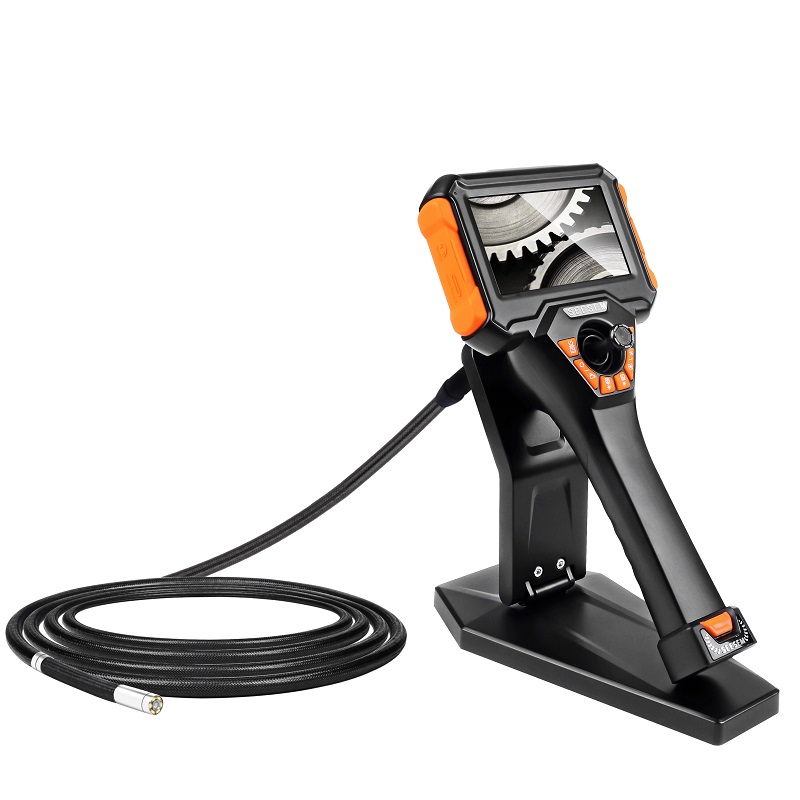Video borescopes, also known as inspection cameras or endoscopes, are essential tools for non-destructive testing in various industries such as aerospace, automotive, and manufacturing. These devices have revolutionized the way professionals inspect hard-to-reach areas of machinery and equipment. In this article, we will discuss the key features of video borescopes.
- High-Quality Imaging: Video borescopes are equipped with high-resolution cameras that produce clear, high-quality images of the inspected area. The images can be viewed in real-time on the device’s built-in screen or transmitted to a computer or mobile device for further analysis.
- Flexible and Durable: The insertion tube of a video borescope is made of a flexible material that allows it to bend and maneuver around corners and obstacles. The insertion tube is also durable and can withstand harsh environments, making it ideal for use in industrial settings.
- Portable and Lightweight: Video borescopes are designed to be portable and lightweight, making them easy to transport to different job sites. They can be easily carried in a backpack or toolbox, and some models even come with a carrying case for added protection.
- User-Friendly Interface: Most video borescopes come with a user-friendly interface that allows professionals to easily adjust the camera’s settings, such as zoom, focus, and lighting. This makes it easy to capture the perfect image for analysis and inspection.
- Versatile: Video borescopes can be used in a variety of industries, from aviation and aerospace to automotive and manufacturing. They can be used to inspect engines, pipes, and other hard-to-reach areas of machinery and equipment.
- Cost-Effective: Video borescopes are a cost-effective alternative to traditional inspection methods, such as dismantling equipment or using x-ray machines. They allow professionals to inspect equipment without causing damage or disruption, which can save time and money.
In conclusion, video borescopes are essential tools for professionals in various industries. They offer high-quality imaging, flexibility, durability, portability, a user-friendly interface, versatility, and cost-effectiveness. With their numerous features, video borescopes have revolutionized non-destructive testing, making inspections easier, safer, and more efficient.

- Detecting Defects: Video borescopes are ideal for detecting defects in machinery and equipment. They can inspect internal components without the need for dismantling, reducing downtime and costs. Defects such as cracks, corrosion, and wear can be easily identified with the use of video borescopes.
- Preventive Maintenance: Video borescopes can be used for preventive maintenance, allowing professionals to detect potential problems before they become serious issues. This helps to reduce equipment downtime and increases the lifespan of machinery and equipment.
- Quality Control: Video borescopes are used in quality control processes to ensure that products meet industry standards. They can inspect internal components of products and identify any defects that may affect their performance.
- Safety Inspection: Video borescopes are used for safety inspections in various industries. They can inspect internal components of equipment and identify any potential hazards or safety concerns, such as leaks or cracks.
- Research and Development: Video borescopes are used in research and development to study the internal components of machinery and equipment. This helps engineers to better understand the design and function of equipment, which can lead to improvements in performance and efficiency.
- Inspection of Aerospace Components: Video borescopes are particularly useful in the aviation industry for inspecting the internal components of aircraft engines and other critical parts. They can identify defects that may cause failures or malfunctions, which could be catastrophic.
In conclusion, video borescopes are versatile tools with a wide range of applications. They are essential for detecting defects, preventive maintenance, quality control, safety inspection, research and development, and aerospace component inspection. With their ability to inspect hard-to-reach areas without dismantling, video borescopes have revolutionized non-destructive testing and have become an essential tool for professionals in various industries.
Video on the use of video borescopes
Q: How far can the insertion tube of a video borescope reach?
A: The length of the insertion tube varies depending on the model of the video borescope. Generally, the insertion tube can reach up to several meters, allowing professionals to inspect deep inside machinery and equipment.
Q: Can video borescopes be used in wet environments?
A: Yes, video borescopes can be used in wet environments. However, it is important to choose a video borescope with a waterproof insertion tube and camera head to ensure that the device can withstand exposure to water and other liquids.
Q: How do you adjust the focus of a video borescope?
A: Most video borescopes come with an adjustable focus feature. The focus can be adjusted by using the device’s controls, such as zoom and focus buttons. Some video borescopes also have a built-in autofocus feature that automatically adjusts the focus as needed.
Q: Can video borescopes be used to inspect live wires or electrical systems?
A: It is not recommended to use video borescopes to inspect live wires or electrical systems, as this can be dangerous and may cause electrocution. It is important to turn off power sources before inspecting electrical systems or to use a different type of inspection tool designed specifically for electrical systems.
Q: What is the maximum temperature that video borescopes can withstand?
A: The maximum temperature that video borescopes can withstand varies depending on the model. It is important to choose a video borescope that is designed for the specific temperature range of the environment being inspected. Some video borescopes can withstand temperatures up to 2000 degrees Fahrenheit.
Q: Can video borescopes be used to inspect fuel tanks?
A: Yes, video borescopes can be used to inspect fuel tanks. However, it is important to use a video borescope that is designed for use in hazardous environments and to follow safety protocols when inspecting fuel tanks.
Q: How do you clean a video borescope?
A: Video borescopes should be cleaned after each use to ensure that they function properly and to prevent damage to the device. The insertion tube and camera head can be cleaned with a soft cloth or brush and a cleaning solution that is specifically designed for video borescopes. It is important to follow the manufacturer’s instructions for cleaning the device.





